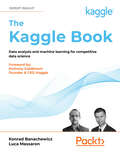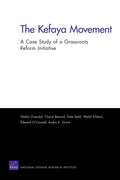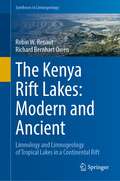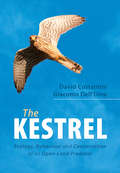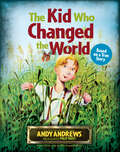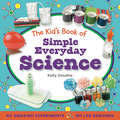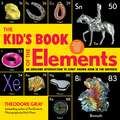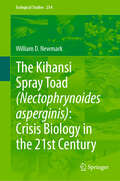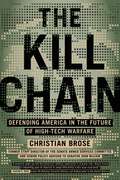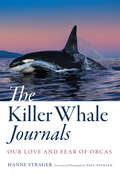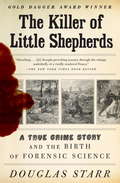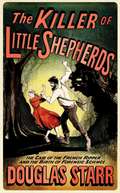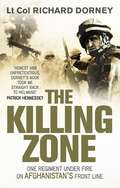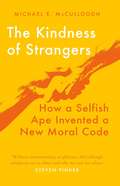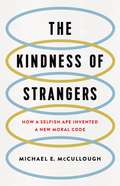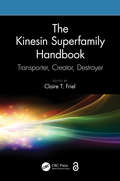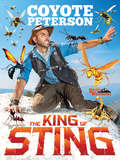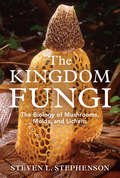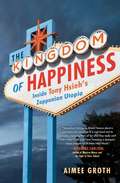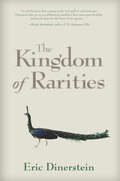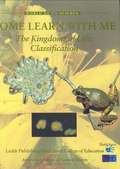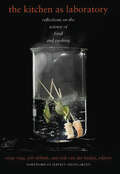- Table View
- List View
The Kaggle Book: Data analysis and machine learning for competitive data science
by Konrad Banachewicz Luca MassaronGet a step ahead of your competitors with insights from over 30 Kaggle Masters and Grandmasters. Discover tips, tricks, and best practices for competing effectively on Kaggle and becoming a better data scientist. Purchase of the print or Kindle book includes a free eBook in the PDF format.Key FeaturesLearn how Kaggle works and how to make the most of competitions from over 30 expert KagglersSharpen your modeling skills with ensembling, feature engineering, adversarial validation and AutoMLA concise collection of smart data handling techniques for modeling and parameter tuningBook DescriptionMillions of data enthusiasts from around the world compete on Kaggle, the most famous data science competition platform of them all. Participating in Kaggle competitions is a surefire way to improve your data analysis skills, network with an amazing community of data scientists, and gain valuable experience to help grow your career. The first book of its kind, The Kaggle Book assembles in one place the techniques and skills you’ll need for success in competitions, data science projects, and beyond. Two Kaggle Grandmasters walk you through modeling strategies you won’t easily find elsewhere, and the knowledge they’ve accumulated along the way. As well as Kaggle-specific tips, you’ll learn more general techniques for approaching tasks based on image, tabular, textual data, and reinforcement learning. You’ll design better validation schemes and work more comfortably with different evaluation metrics. Whether you want to climb the ranks of Kaggle, build some more data science skills, or improve the accuracy of your existing models, this book is for you. Plus, join our Discord Community to learn along with more than 1,000 members and meet like-minded people!What you will learnGet acquainted with Kaggle as a competition platformMake the most of Kaggle Notebooks, Datasets, and Discussion forumsCreate a portfolio of projects and ideas to get further in your careerDesign k-fold and probabilistic validation schemesGet to grips with common and never-before-seen evaluation metricsUnderstand binary and multi-class classification and object detectionApproach NLP and time series tasks more effectivelyHandle simulation and optimization competitions on KaggleWho this book is forThis book is suitable for anyone new to Kaggle, veteran users, and anyone in between. Data analysts/scientists who are trying to do better in Kaggle competitions and secure jobs with tech giants will find this book useful. A basic understanding of machine learning concepts will help you make the most of this book.
The Kaguya Lunar Atlas: The Moon in High Resolution
by Charles A. Wood Motomaro ShiraoIn late 2007, the Japanese Space Exploration Agency (JAXA) placed the Kaguya/ Selene spacecraft in orbit around the Moon to probe the Moon’s surface and interior. But unlike previous lunar orbiters, Kaguya carries a high definition television camera (HDTV) sent beyond Earth orbit. Sponsored by the Japanese NHK TV network, the HDTV has amazed both scientists and the public with its magnificent views of the lunar surface. What makes these images so much more engaging than standard vertical view lunar photography is that they are taken looking obliquely along the flight path. Thus, they show the Moon as it would be seen by an astronaut looking through a porthole window while orbiting only 100 km above the lunar surface. This is the view we all would wish to have but are never likely to, except vicariously through the awe-inspiring Kaguya HDTV images. Each page features a HDTV image with a map of the entire Moon on the upper left showing where the image is located. On the upper right is a 100-150 word description. Seeing the Moon is not intended solely for lunar scientists who are striving to work out the mysteries of the Moon’s origin and evolution. Everyone can appreciate the natural beauty and be entranced by the view of the nearby world where humans may one day live.
The Kefaya Movement
by Cheryl Benard Edward O'Connell Dale Stahl Nadia Oweidat Walid KildaniKefaya was an indigenous movement for political reform organized in late2004 in opposition to the regime of Egyptian President Hosni Mubarak. Thisexamination of Kefaya's birth, accomplishments, and decline is based on ananalysis of the work of Egyptian scholars and Arabic-language media reports(including online and new media), as well as structured interviews withpersons associated with and observers of Kefaya and the Muslim Brotherhood.
The Kenya Rift Lakes: Limnology and Limnogeology of Tropical Lakes in a Continental Rift (Syntheses in Limnogeology)
by Robin W. Renaut Richard Bernhart OwenThis book is the first comprehensive account of the modern Kenya Rift Valley lakes and their precursor lakes preserved in the sedimentary record. The first part gives the broad geological and environmental background to the Kenya Rift and a history of research. In the second part, each modern lake is described from perspectives of geology, limnology, ecology, sedimentology and late Quaternary history. The fossil lake sediments, some linked to hominin sites, and their paleoenvironmental history are considered in the third part. In the fourth section, the global tectonic, volcanic and climate controls of lake evolution in continental rifts are examined. The last section discusses the resource potential of the lakes and their sediments, and the environmental issues that currently affect the modern lakes. This research-level book (geology, paleoecology) is illustrated throughout by original figures and photographs.
The Kestrel: Ecology, Behaviour and Conservation of an Open-Land Predator
by David Costantini Giacomo Dell'OmoWidespread across open lands and cities of Europe, Africa, and Asia, the common kestrel (Falco tinnunculus) is one of the most abundant and studied birds of prey. This book brings together and synthesises the results of research on kestrels for professional ornithologists and scientists that seek to consolidate a vast body of literature. It is also a reference for those readers who may not have the depth of scientific knowledge to navigate new fields of scientific enquiry. It examines many aspects of the species' biology, from the reproductive strategies to the behavioural and demographic adaptations to changes of environmental conditions. It also discusses the roles of physiology and immunology in mediating the adaptability of kestrels to the ongoing environmental changes with a particular focus on contaminants. This volume presents new and exciting avenues of research on the ecology and behaviour of the common kestrel.
The Key Muscles of Yoga: Scientific Keys, Volume I
by Ray LongThis book offers a scientific approach to understanding the practice of hatha yoga. T Specific anatomical and physiological descriptions highlight the agonist, antagonist, and synergist muscles that come into play with each pose. Volume I of the series describes the key muscles of hatha yoga and how they are utilized. From beginners to experts, this book will become a constant companion.
The Kid Who Changed the World
by Andy AndrewsThe bestselling book now featuring revised content and new illustrations!The Kid Who Changed the World tells the story of Norman Borlaug, who would one day grow up and use his knowledge of agriculture to save the lives of two billion people. Two billion! Norman changed the world! Or was it Vice President Henry Wallace who changed the world? Or maybe it was George Washington Carver? But what about Susan Carver?This engaging story reveals the incredible truth that everything we do matters! Based on his book The Butterfly Effect, Andy&’s timeless tale shows children that even the smallest of our actions can make a difference in someone&’s life. In turn, that person makes a difference in someone else&’s life, and the blessing is passed from person to person. Through each character&’s story, readers will see that they, too, can be the kid who changes the world.Now updated with Susan Carver&’s story and brand-new illustrations by Phillip Hurst!Features & Benefits:Based on true storiesHelps children understand that everything they do makes a differenceBased on The Butterfly Effect by New York Times bestselling author Andy AndrewsUpdated illustrations by Phillip Hurst
The Kid's Book of Simple Everyday Science
by Kelly DoudnaThese 40 simple science activities will have young kids searching the house for everyday items to learn about temperature, pressure, water, air, heat, and plants! Each easy and fun activity includes how-to photos, simple instructions, short explanations, and introduces beginning math principles. With tips and extra information to extend the scientific experience, this book will get kids thinking like scientists in no time at all! The book includes: supply & tool lists, visual and text-based explanations, step-by-step instructions and photos, and safety information.
The Kid's Book of the Elements: An Awesome Introduction to Every Known Atom in the Universe
by Theodore GrayA fun, fascinating, and amazingly photographic exploration of the periodic table, for curious kids who want to understand how atoms and elements make up everything in the universe.In this very special kids' edition of Theodore Gray's The Elements, budding scientists, ages 6 to 9, will learn all about every element in the periodic table from the first element, Hydrogen (1), to the very last element, Oganesson (118). Filled with great big colorful photographs and fun facts for every element, The Kid's Book of The Elements is the perfect introduction to the fascinating world of chemistry and visual/tactile-based STEM/STEAM learning. This edition also includes 120 sturdy tear-out cards of each element for kids to play with and arrange on their own.
The Kihansi Spray Toad (Ecological Studies #254)
by William D. NewmarkThe captive breeding and reintroduction of highly threatened species are among the most challenging conservation interventions and often represent the final tool in a comparatively small toolbox to conserve rapidly declining species. This book details the species recovery program that was designed and implemented over two decades to conserve the Kihansi Spray Toad (Nectophrynoides asperginis), an extinct-in-the-wild tropical amphibian. More than 20 international and national institutions were involved in the design and implementation of the species recovery program. This complex two-decade effort highlights the challenges of conserving highly threatened tropical amphibians and integrating conservation with development in the 21st century. This volume will appeal to biologists, conservation and development practitioners, and institutions and individuals concerned about the conservation of biodiversity.
The Kill Chain: Defending America in the Future of High-Tech Warfare
by Christian BroseFor generations of Americans, our country has been the world's dominant military power. How the US military fights, and the systems and weapons that it fights with, have been uncontested. That old reality, however, is rapidly deteriorating. America's traditional sources of power are eroding amid the emergence of new technologies and the growing military threat posed by rivals such as China. America is at grave risk of losing a future war.As Christian Brose reveals in this urgent wake-up call, the future will be defined by artificial intelligence, autonomous systems, and other emerging technologies that are revolutionizing global industries and are now poised to overturn the model of American defense. This fascinating, if disturbing, book confronts the existential risks on the horizon, charting a way for America's military to adapt and succeed with new thinking as well as new technology. America must build a battle network of systems that enables people to rapidly understand threats, make decisions, and take military actions, the process known as "the kill chain." Examining threats from China, Russia, and elsewhere, The Kill Chain offers hope and, ultimately, insights on how America can apply advanced technologies to prevent war, deter aggression, and maintain peace.
The Killer Strain: Anthrax and a Government Exposed
by Marilyn W. ThompsonA lethal germ is unleashed in the U.S. mail. A chain of letters spreads terror from Florida to Washington, D.C., from New York to Connecticut, from the halls of Congress to the assembly lines of the U.S. Postal Service. Five people die, and ten thousand more line up for antibiotics to protect against exposure. The government, already outsmarted by the terrorist hijackers of 9/11, leaves its workers vulnerable and a diabolical killer on the loose.Based on hundreds of hours of interviews and a review of thousands of pages of government documents, The Killer Strain is the definitive account of the year in which bioterrorism became a reality in the United States. Revealing the little-known victims and unsung heroes in the anthrax debacle, investigative reporter Marilyn Thompson also examines the FBI's slow-paced investigation of the crimes and the unprecedented scientific challenges posed by the case.The Killer Strain, more than just a thrilling read, is also a clarion wake-up call. It shows how billions of dollars and a decade of elaborate bioterror dress rehearsals meant nothing in the face of a real attack -- and how we may still be at risk.
The Killer Whale Journals: Our Love and Fear of Orcas
by Hanne StragerExperience the hauntingly beautiful world of orcas, and discover the stories that unfold when humans enter oceans alongside them.When intrepid biology student Hanne Strager volunteered to be the cook on a small research vessel in Norway's Lofoten Islands, the trip inspired a decades-long journey into the lives of killer whales—and an exploration of people's complex relationships with the biggest predators on earth. The Killer Whale Journals chronicles the now internationally renowned science writer's fascinating adventures around the world, documenting Strager's personal experiences with orcas in the wild. Killer whales' incredible intelligence, long life spans, and strong family bonds lead many people to see them as kindred spirits in the sea. But not everyone feels this way—like wolves, orcas have been both beloved and vilified throughout human history. In this absorbing odyssey, Strager traces the complicated relationship between humans and killer whales, while delving into their behavior, biology, and ecology. She brings us along in her travels to the most remote corners of the world, battling the stormy Arctic seas of northern Norway with fellow biologists intent on decoding whale-song, interviewing First Nations conservationists in Vancouver, observing Inuit hunters in Greenland, and witnessing the dismantling of black market "whale jails" in the Russian wilderness of Kamchatka. Through these captivating stories, Strager introduces us to a diverse cast of characters from Inuit elders to Australian Aboriginal whalers and guides us through the world's wild waters, from fjords above the Arctic circle in Norway to the poaching-infested waters off Kamchatka. Featuring astonishing photographs from famed nature photographer and conservationist Paul Nicklen, The Killer Whale Journals reveals rare and intimate moments of connection with these fierce, brilliant predators.
The Killer of Little Shepherds
by Douglas StarrA riveting true crime story that vividly recounts the birth of modern forensics.At the end of the nineteenth century, serial murderer Joseph Vacher, known and feared as "The Killer of Little Shepherds," terrorized the French countryside. He eluded authorities for years--until he ran up against prosecutor Emile Fourquet and Dr. Alexandre Lacassagne, the era's most renowned criminologist. The two men--intelligent and bold--typified the Belle Époque, a period of immense scientific achievement and fascination with science's promise to reveal the secrets of the human condition. With high drama and stunning detail, Douglas Starr revisits Vacher's infamous crime wave, interweaving the story of how Lacassagne and his colleagues were developing forensic science as we know it. We see one of the earliest uses of criminal profiling, as Fourquet painstakingly collects eyewitness accounts and constructs a map of Vacher's crimes. We follow the tense and exciting events leading to the murderer's arrest. And we witness the twists and turns of the trial, celebrated in its day. In an attempt to disprove Vacher's defense by reason of insanity, Fourquet recruits Lacassagne, who in the previous decades had revolutionized criminal science by refining the use of blood-spatter evidence, systematizing the autopsy, and doing groundbreaking research in psychology. Lacassagne's efforts lead to a gripping courtroom denouement. The Killer of Little Shepherds is an important contribution to the history of criminal justice, impressively researched and thrillingly told.From the Hardcover edition.
The Killer of Little Shepherds: The Case of the French Ripper and the Birth of Forensic Science
by Douglas StarrAt the end of the nineteenth century, serial murderer Joseph Vacher, dubbed "The Killer of Little Shepherds," terrorized the French countryside. He eluded authorities for years-until he ran up against prosecutor Emile Fourquet and Dr. Alexandre Lacassagne, the era's most renowned criminologist. The two men typified the Belle Epoque, a period of immense scientific achievement and fascination with its promise to reveal the secrets of the human condition. With high drama and stunning detail, Douglas Starr recounts the infamous crime and punishment of Vacher, interweaving the story of how Lacassagne and his colleagues developed forensics as we know it. We see one of the earliest uses of criminal profiling, as Fourquet painstakingly collects eyewitness accounts, leading to Vacher's arrest. And we see the twists and turns of the celebrated trial: to disprove Vacher's defense by reason of insanity, Fourquet recruits Lacassagne, who had revolutionized criminal science: refining the use of blood spatter evidence, systematizing the autopsy and doing ground-breaking research in psychology. Lacassagne's forensic investigation ranks among the greatest of all time, and its denouement is gripping. An important contribution to the history of medicine and criminal justice, impressively researched and thrillingly told.
The Killing Zone
by Richard DorneyOn a tour of duty in the Helmand River Valley, the Grenadier Guards faced the toughest challenge of their lives...Carrying out patrols in the most fiercely contested land in Afghanistan the Guards were under fire almost constantly. The summer of 2007 saw some of the most frequent and intense combat yet, beyond what anyone could have predicted. Based in isolated forward operating bases their nearest reinforcements were often miles away, down a track strewn with deadly roadside bombs. The Killing Zone is an action-packed and authentic insight into the real Afghanistan. This is what it’s like to deliberately draw fire on your own position so that your mates can escape an ambush, to experience the adrenaline rush of being the first in to clear a Taliban compound, and to rely on skill, loyalty and quick-thinking to survive in one of the most dangerous places on earth.
The Kindness of Strangers: How a Selfish Ape Invented a New Moral Code
by Michael E. McCulloughWhy do we give a damn about strangers? Altruism is unique to the human species. It is also one of the great evolutionary puzzles, and we may be on the brink of solving it. It turns out that, over the last 12,000 years, we have become more and more altruistic. This is despite the fact that, the majority of the time, our minds are still breathtakingly indifferent to the welfare of others. In solving the enigma of generosity in a world of strangers, McCullough takes us on a sweeping history of society and science to warn that, if we are not careful, our instincts and sympathies have as much potential for harm as for good. The bad news is that we are not designed to be kind. The good news is that we can push ourselves to be kind anyway, together.
The Kindness of Strangers: How a Selfish Ape Invented a New Moral Code
by Michael E. McCulloughA sweeping psychological history of human goodness -- from the foundations of evolution to the modern political and social challenges humanity is now facing. How did humans, a species of self-centered apes, come to care about others? Since Darwin, scientists have tried to answer this question using evolutionary theory. In The Kindness of Strangers, psychologist Michael E. McCullough shows why they have failed and offers a new explanation instead. From the moment nomadic humans first settled down until the aftermath of the Second World War, our species has confronted repeated crises that we could only survive by changing our behavior. As McCullough argues, these choices weren't enabled by an evolved moral sense, but with moral invention -- driven not by evolution's dictates but by reason. Today's challenges -- climate change, mass migration, nationalism -- are some of humanity's greatest yet. In revealing how past crises shaped the foundations of human concern, The Kindness of Strangers offers clues for how we can adapt our moral thinking to survive these challenges as well.
The Kinesin Superfamily Handbook: Transporter, Creator, Destroyer
by Claire T. FrielThis book brings together current information on the families that make up the kinesin superfamily of molecular motors in one comprehensive text; an ideal reference for researchers looking to make comparisons between different families, for specific information on an individual family, or simply for an overview of the kinesin superfamily.Information is clearly structured and grouped according to individual families and organised in a standardised way, allowing the reader to easily search and retrieve information on this large superfamily of molecular motors and understand how its individual members carry out a diverse variety of cellular functions. Features: The first book dedicated to the entire kinesin superfamily Enables a fuller understanding of this family of proteins, which is becoming an increasing focus of research due to its involvement in diseases such as cancer, neuropathies and ciliopathies. Written in a manner accessible to a range of researchers in the life and medical sciences, including biophysicists, biochemists and medical researchers. Chapter 4 of this book is freely available as a downloadable Open Access PDF under a Creative Commons Attribution-Non Commercial-No Derivatives 4.0 license. Chapter 11 of this book is freely available as a downloadable Open Access PDF under a Creative Commons Attribution-Non Commercial-No Derivatives 4.0 license.
The King of Sting (Brave Wilderness)
by Coyote Petersonp.p1 {margin: 0.0px 0.0px 0.0px 0.0px; font: 15.0px Calibri; -webkit-text-stroke: #000000} span.s1 {font-kerning: none} Wildlife expert Coyote Peterson brings his 12.5 million YouTube subscribers and legions of kid fans a highly designed, full-color exploration of his "Sting Zone" adventure series, culminating in his thrilling encounter with the "King of Sting"--the Executioner Wasp. Coyote Peterson, YouTube star, animal enthusiast, and creator of the Brave Adventure series, has tracked down some of the world's most painfully stinging insects and chronicled getting stung by each of them on his YouTube channel. Coyote has saved the best--or possibly the worst--for last, and he's finally ready to share his experience with the most painful sting in the world: the Executioner Wasp. Featuring full-color stills from his show, and packed with facts about nature's most misunderstood creatures, King of Sting is a dream book for any kid that loves animals, bugs, outdoor exploration, and danger!
The Kingdom Fungi: The Biology of Mushrooms, Molds, and Lichens
by Steven L. StephensonThe ubiquitous fungi are little known and vastly underappreciated. Yet, without them we wouldn’t have bread, alcohol, cheese, tofu, or the unique flavors of mushrooms, morels, and truffles. We can’t survive without fungi. The Kingdom Fungi provides a comprehensive look at the biology, structure, and morphological diversity of these necessary organisms. It sheds light on their ecologically important roles in nature, their fascinating relationships with people, plants, and animals, and their practical applications in the manufacture of food, beverages, and pharmaceuticals. The book includes information about “true” fungi, fungus-like creatures (slime molds and water molds), and a group of “composite” organisms (lichens) that are more than just fungi. Particular attention is given to examples of fungi that might be found in the home and encountered in nature. The Kingdom Fungi is a useful introductory text for naturalists, mycologists, and anyone who wants to become more familiar with, and more appreciative of, the fascinating world of fungi.
The Kingdom of Happiness: Inside Tony Hsieh's Zapponian Utopia
by Aimee GrothFearless gonzo journalism—an insider’s look at the enigmatic and successful CEO of Zappos, Tony Hsieh, and his quest to create his own version of utopia in the center of Las Vegas.In 2010 Tony Hsieh was introduced to many as a visionary modern business leader. Under Hsieh’s leadership, Zappos became the world’s largest online shoe company by championing satisfied customers and a valued workforce. After his company was purchased by Amazon, even as he continued as its CEO, Hsieh engaged his energies and considerable fortune toward a much larger goal: building a new and more socially conscious Silicon Valley in the heart of downtown Las Vegas, all within his five-year plan. Hsieh challenged business and technology journalist Aimee Groth to uproot her life and participate in his social engineering experiment. Beginning with couch surfing, moving to a Downtown Project crash pad, and then living in Zappos corporate housing above the Gold Spike bar, Groth had a front-row view of Hsieh’s efforts to build his ideal society. With interviews from insiders on all ends of the Zappos spectrum—like the “broken dolls” who gravitate toward Hsieh’s almost cultlike personality and make up some of his inner circle, to the Zapponians who live and work on campus, to players in the top echelon of Silicon Valley—Groth offers a unique view of a world few people know much about, and sheds a new light on this complex, eccentric man. The Kingdom of Happiness is the story of one man’s quest to create his own nirvana in the desert based on his exacting design and experimentation with lessons he’s gleaned not only from the incredible success of Zappos, but also from rave culture and Burning Man. Is it the business model of the future or a cautionary tale of hubris?
The Kingdom of Rarities
by Eric DinersteinWhen you look out your window, why are you so much more likely to see a robin or a sparrow than a Kirtland's warbler or a California condor? Why are some animals naturally rare and others so abundant? The quest to find and study seldom-seen jaguars and flamboyant Andean cocks-of-the-rock is as alluring to naturalists as it is vitally important to science. From the Himalayan slopes of Bhutan to the most isolated mountain ranges of New Guinea, The Kingdom of Rarities takes us to some of the least-traveled places on the planet to catch a glimpse of these unique animals and many others. As he shares stories of these species, Eric Dinerstein gives readers a deep appreciation of their ecological importance and the urgency of protecting all types of life -- the uncommon and abundant alike. An eye-opening tour of the rare and exotic, The Kingdom of Rarities offers us a new understanding of the natural world, one that places rarity at the center of conservation biology. Looking at real-time threats to biodiversity, from climate change to habitat fragmentation, and drawing on his long and distinguished scientific career, Dinerstein offers readers fresh insights into fascinating questions about the science of rarity and unforgettable experiences from the field.
The Kingdoms of Life: Classification
by Bridget AndersonMore than two million different species of organisms live on Earth--in all kinds of climates and places, ranging from the freezing North Pole to hot and steamy jungles, and from the highest mountains to the nethermost depths of the oceans. How do we keep track of the teeming abundance of life on Earth? Throughout history, humans have always been busy naming and classifying all living things. That process continues today. THE KINGDOMS OF LIFE: CLASSIFICATION explores the amazing diversity of life on Earth and details one way scientists currently organize their records to make sure no organism is left unnamed and unclassified.
The Kitchen as Laboratory: Reflections on the Science of Food and Cooking (Arts and Traditions of the Table Perspectives on Culinary History)
by César Vega, Job Ubbink and Erik van der Linden&“Provides good perspective on the scientific approach to cooking while reflecting the interests and passions of each essay&’s author.&”—Peter Barham, author of The Science of CookingIn this global collaboration of essays, chefs and scientists advance culinary knowledge by testing hypotheses rooted in the physical and chemical properties of food. Using traditional and cutting-edge tools, ingredients, and techniques, these pioneers create, and sometimes revamp, dishes that respond to specific desires and serve up an original encounter with gastronomic practice. From the seemingly mundane to the food fantastic—from grilled cheese sandwiches, pizzas, and soft-boiled eggs to Turkish ice cream, sugar glasses, and jellified beads—the essays in The Kitchen as Laboratory cover a range of creations and their history and culture. This collection will delight experts and amateurs alike, especially as restaurants rely more on science-based cooking and recreational cooks increasingly explore the physics and chemistry behind their art. Contributors end each essay with their personal thoughts on food, cooking, and science, offering rare insight into a professional&’s passion for playing with food.&“Where else can one have fun pondering the acoustics of crunchy foods or the texture of an ice cream that stretches like a rubber band?&”—Robert Wolke, author of What Einstein Told His Cook: Kitchen Science Explained &“Not only an in-depth study of many areas of food science, but also an entertaining read. For someone like me, who relishes understanding more about cooking from the inside out, it&’s heartening to see this area of literature expanded.&”—Chef Wylie Dufresne, wd~50
